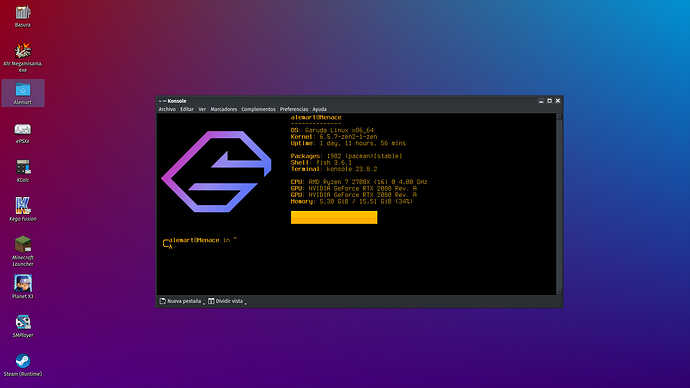Hello again ![]()
I am trying to set the terminal console to my liking, so far, so good. But there is one thing that I have not been able to figure out, fastfetch.
I have read the help of fastfetch, but it has not indicated me where to find the file, just the name, I have also read several forum posts, but those instructions are not working, as I have not been able to even find many of the folders indicated.
As I understand, I need to locate the fastfetch configuration file and manually edit it, so that the changes will be permanent.
I am including the inxi results.
System:
Kernel: 6.5.7-zen1-1-zen arch: x86_64 bits: 64 compiler: gcc v: 13.2.1
clocksource: tsc available: hpet,acpi_pm
parameters: BOOT_IMAGE=/@/boot/vmlinuz-linux-zen
root=UUID=3db864a1-d307-4cea-b8b8-e25163eaa31a rw rootflags=subvol=@
quiet quiet rd.udev.log_priority=3 vt.global_cursor_default=0 loglevel=3
ibt=off
Desktop: KDE Plasma v: 5.27.8 tk: Qt v: 5.15.11 wm: kwin_x11 vt: 2
dm: SDDM Distro: Garuda Linux base: Arch Linux
Machine:
Type: Desktop Mobo: ASUSTeK model: ROG STRIX B450-F GAMING II v: Rev 1.xx
serial: <superuser required> UEFI: American Megatrends v: 4007
date: 12/08/2020
CPU:
Info: model: AMD Ryzen 7 2700X bits: 64 type: MT MCP arch: Zen+ gen: 2
level: v3 note: check built: 2018-21 process: GF 12nm family: 0x17 (23)
model-id: 8 stepping: 2 microcode: 0x800820D
Topology: cpus: 1x cores: 8 tpc: 2 threads: 16 smt: enabled cache:
L1: 768 KiB desc: d-8x32 KiB; i-8x64 KiB L2: 4 MiB desc: 8x512 KiB
L3: 16 MiB desc: 2x8 MiB
Speed (MHz): avg: 3997 high: 4000 min/max: 2200/4000 boost: disabled
scaling: driver: acpi-cpufreq governor: performance cores: 1: 4000 2: 4000
3: 3991 4: 3990 5: 4000 6: 4000 7: 4000 8: 3993 9: 4000 10: 3990 11: 4000
12: 4000 13: 4000 14: 4000 15: 4000 16: 4000 bogomips: 127742
Flags: avx avx2 ht lm nx pae sse sse2 sse3 sse4_1 sse4_2 sse4a ssse3 svm
Vulnerabilities: <filter>
Graphics:
Device-1: NVIDIA TU104 [GeForce RTX 2080 Rev. A] vendor: Micro-Star MSI
driver: nvidia v: 535.113.01 alternate: nouveau,nvidia_drm non-free: 535.xx+
status: current (as of 2023-09) arch: Turing code: TUxxx
process: TSMC 12nm FF built: 2018-22 pcie: gen: 3 speed: 8 GT/s lanes: 8
link-max: lanes: 16 bus-ID: 08:00.0 chip-ID: 10de:1e87 class-ID: 0300
Device-2: NVIDIA TU104 [GeForce RTX 2080 Rev. A] vendor: ZOTAC
driver: nvidia v: 535.113.01 alternate: nouveau,nvidia_drm non-free: 535.xx+
status: current (as of 2023-09) arch: Turing code: TUxxx
process: TSMC 12nm FF built: 2018-22 pcie: gen: 1 speed: 2.5 GT/s lanes: 4
link-max: gen: 3 speed: 8 GT/s lanes: 16 bus-ID: 09:00.0
chip-ID: 10de:1e87 class-ID: 0300
Display: x11 server: X.Org v: 21.1.8 with: Xwayland v: 23.2.1
compositor: kwin_x11 driver: X: loaded: modesetting,nouveau,nvidia
alternate: fbdev,nv,vesa gpu: nvidia,nvidia display-ID: :0 screens: 1
Screen-1: 0 s-res: 1920x1080 s-dpi: 101 s-size: 483x272mm (19.02x10.71")
s-diag: 554mm (21.82")
Monitor-1: HDMI-0 pos: primary res: 1920x1080 hz: 75 dpi: 102
size: 480x270mm (18.9x10.63") diag: 551mm (21.68") modes: N/A
Monitor-2: None-2-1 size-res: N/A modes: N/A
API: EGL v: 1.5 hw: drv: nvidia platforms: gbm: drv: nvidia
API: OpenGL v: 4.6.0 vendor: nvidia v: 535.113.01 glx-v: 1.4
direct-render: yes renderer: NVIDIA GeForce RTX 2080/PCIe/SSE2
memory: 7.81 GiB
API: Vulkan v: 1.3.264 layers: 14 device: 0 type: discrete-gpu
name: NVIDIA GeForce RTX 2080 driver: nvidia v: 535.113.01
device-ID: 10de:1e87 surfaces: xcb,xlib device: 1 type: discrete-gpu
name: NVIDIA GeForce RTX 2080 driver: nvidia v: 535.113.01
device-ID: 10de:1e87 surfaces: N/A device: 2 type: cpu name: llvmpipe
(LLVM 16.0.6 256 bits) driver: mesa llvmpipe v: 23.2.1-arch1.2 (LLVM
16.0.6) device-ID: 10005:0000 surfaces: xcb,xlib
Audio:
Device-1: Creative Labs CA0132 Sound Core3D [Sound Blaster Recon3D /
Z-Series BlasterX AE-5 Plus] driver: snd_hda_intel v: kernel pcie: gen: 1
speed: 2.5 GT/s lanes: 1 bus-ID: 05:00.0 chip-ID: 1102:0012 class-ID: 0403
Device-2: NVIDIA TU104 HD Audio vendor: Micro-Star MSI
driver: snd_hda_intel v: kernel pcie: gen: 3 speed: 8 GT/s lanes: 8
link-max: lanes: 16 bus-ID: 08:00.1 chip-ID: 10de:10f8 class-ID: 0403
Device-3: NVIDIA TU104 HD Audio vendor: ZOTAC driver: snd_hda_intel
v: kernel pcie: gen: 3 speed: 8 GT/s lanes: 4 link-max: lanes: 16
bus-ID: 09:00.1 chip-ID: 10de:10f8 class-ID: 0403
API: ALSA v: k6.5.7-zen1-1-zen status: kernel-api with: aoss
type: oss-emulator tools: N/A
Server-1: PipeWire v: 0.3.82 status: active with: 1: pipewire-pulse
status: active 2: wireplumber status: active 3: pipewire-alsa type: plugin
4: pw-jack type: plugin tools: pactl,pw-cat,pw-cli,wpctl
Network:
Device-1: Intel I211 Gigabit Network vendor: ASUSTeK driver: igb v: kernel
pcie: gen: 1 speed: 2.5 GT/s lanes: 1 port: e000 bus-ID: 03:00.0
chip-ID: 8086:1539 class-ID: 0200
IF: enp3s0 state: up speed: 1000 Mbps duplex: full mac: <filter>
Drives:
Local Storage: total: 2.75 TiB used: 63.12 GiB (2.2%)
SMART Message: Unable to run smartctl. Root privileges required.
ID-1: /dev/nvme0n1 maj-min: 259:0 vendor: Intel model: SSDPEKNW020T8
size: 1.86 TiB block-size: physical: 512 B logical: 512 B speed: 31.6 Gb/s
lanes: 4 tech: SSD serial: <filter> fw-rev: 004C temp: 38.9 C scheme: GPT
ID-2: /dev/sda maj-min: 8:0 vendor: Kingston model: SA400S37480G
size: 447.13 GiB block-size: physical: 512 B logical: 512 B speed: 6.0 Gb/s
tech: SSD serial: <filter> fw-rev: T1.3 scheme: GPT
ID-3: /dev/sdb maj-min: 8:16 vendor: Western Digital
model: WD5000AAKS-00TMA0 size: 465.76 GiB block-size: physical: 512 B
logical: 512 B type: USB rev: 3.0 spd: 5 Gb/s lanes: 1 mode: 3.2 gen-1x1
tech: N/A serial: <filter> scheme: MBR
Partition:
ID-1: / raw-size: 1.86 TiB size: 1.86 TiB (100.00%) used: 63.12 GiB (3.3%)
fs: btrfs dev: /dev/nvme0n1p2 maj-min: 259:2
ID-2: /boot/efi raw-size: 300 MiB size: 299.4 MiB (99.80%)
used: 576 KiB (0.2%) fs: vfat dev: /dev/nvme0n1p1 maj-min: 259:1
ID-3: /home raw-size: 1.86 TiB size: 1.86 TiB (100.00%)
used: 63.12 GiB (3.3%) fs: btrfs dev: /dev/nvme0n1p2 maj-min: 259:2
ID-4: /var/log raw-size: 1.86 TiB size: 1.86 TiB (100.00%)
used: 63.12 GiB (3.3%) fs: btrfs dev: /dev/nvme0n1p2 maj-min: 259:2
ID-5: /var/tmp raw-size: 1.86 TiB size: 1.86 TiB (100.00%)
used: 63.12 GiB (3.3%) fs: btrfs dev: /dev/nvme0n1p2 maj-min: 259:2
Swap:
Kernel: swappiness: 133 (default 60) cache-pressure: 100 (default) zswap: no
ID-1: swap-1 type: zram size: 15.51 GiB used: 263.8 MiB (1.7%)
priority: 100 comp: zstd avail: lzo,lzo-rle,lz4,lz4hc,842 max-streams: 16
dev: /dev/zram0
Sensors:
System Temperatures: cpu: 46.0 C mobo: 38.0 C gpu: nvidia temp: 36 C
Fan Speeds (rpm): cpu: 2376 case-1: 0 case-2: 0 case-3: 0 gpu: nvidia
fan: 26%
Power: 12v: 10.08 5v: N/A 3.3v: N/A vbat: 3.23
Info:
Processes: 427 Uptime: 2d 11h 52m wakeups: 2 Memory: total: 16 GiB
available: 15.51 GiB used: 6.71 GiB (43.3%) Init: systemd v: 254
default: graphical tool: systemctl Compilers: gcc: 13.2.1 Packages:
pm: pacman pkgs: 1981 libs: 566 tools: octopi,paru Shell: fish v: 3.6.1
default: Bash v: 5.1.16 running-in: konsole inxi: 3.3.30
Garuda (2.6.17-1):
System install date: 2023-10-08
Last full system update: 2023-10-14
Is partially upgraded: No
Relevant software: snapper NetworkManager dracut nvidia-dkms
Windows dual boot: No/Undetected
Failed units:
Thanks for the help!



